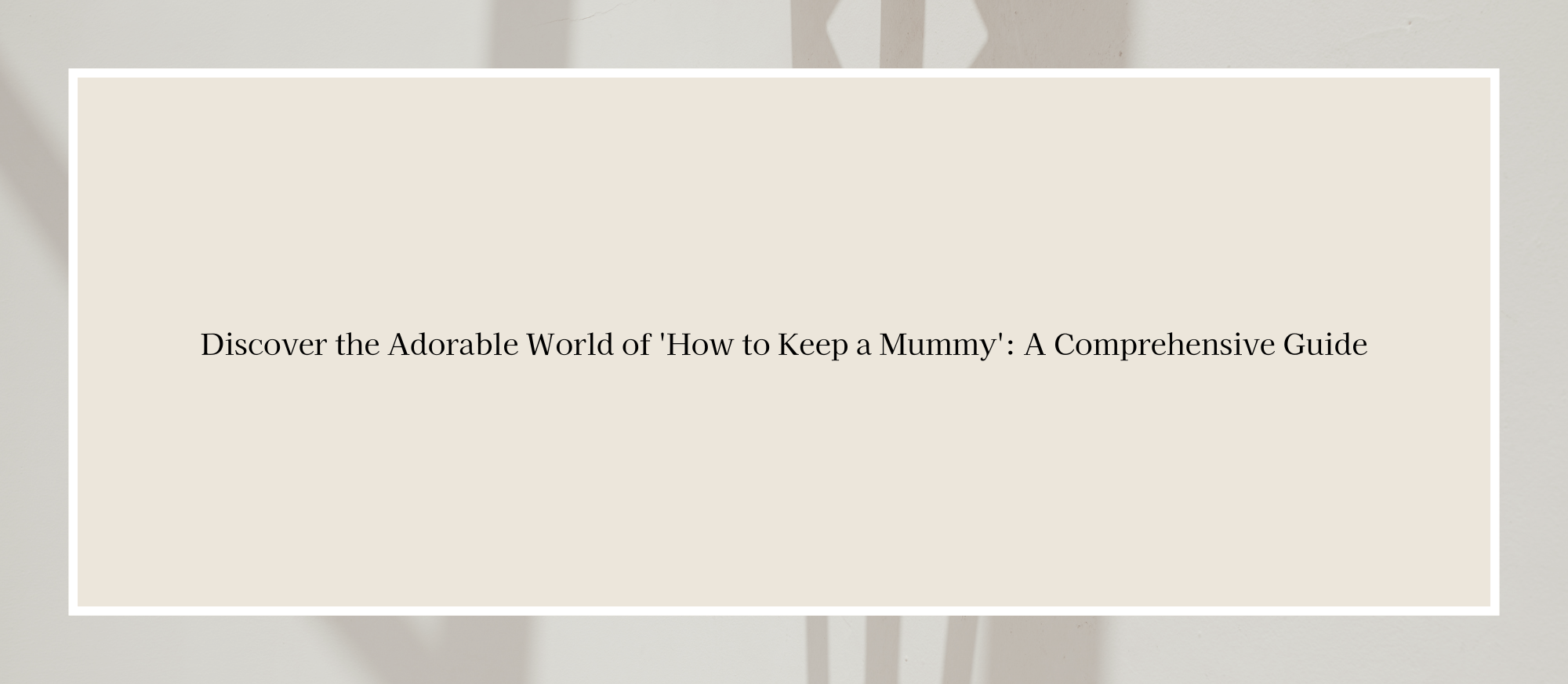Article Structure
- Introduction to 'How to Keep a Mummy'
- Overview of the anime’s premise and setting.
- Introduction to the main characters, including Sora Kashiwagi and the adorable mummy, Mii-kun.
- Brief mention of the series' popularity and its appeal to audiences.
- Character Development and Dynamics
- Detailed descriptions of the main characters and their backgrounds.
- Exploration of the relationships between the characters, focusing on the bond between Sora and Mii-kun.
- Analysis of character growth and interactions that drive the plot forward.
- Plot Highlights and Key Episodes
- Summary of major plot points and story arcs.
- Discussion of key episodes that define the series.
- Exploration of significant moments and their impact on the characters and overall narrative.
- Themes and Symbolism
- Discussion of major themes such as friendship, family, and care.
- Examination of how these themes are portrayed through the characters' experiences.
- Analysis of the symbolism used in the series to enhance storytelling.
- Reception and Future Prospects
- Summary of the series' reception by audiences and critics.
- Discussion on the cultural impact of 'How to Keep a Mummy' and its contribution to the genre.
- Speculation on potential future seasons or spin-offs based on the current storyline.
This structured approach will provide a thorough and engaging overview of "How to Keep a Mummy," making it appealing to both fans of the series and those new to this delightful anime.
Character Development and Dynamics

"How to Keep a Mummy" excels in creating compelling character development and dynamics that deeply engage its audience. At the heart of the series are its main characters, whose backgrounds and relationships are meticulously crafted to drive the story forward.
Sora Kashiwagi is the protagonist, a high school student who is unexpectedly entrusted with the care of a tiny mummy named Mii-kun. Sora is depicted as a compassionate and responsible individual. Initially, he is bewildered by the sudden arrival of Mii-kun, but his kindness and sense of duty quickly take over. Sora's character is relatable to many viewers, as he navigates the typical challenges of adolescence alongside his newfound responsibility.
Mii-kun, the adorable mummy, is a central figure in the series. Despite being a mythical creature, Mii-kun exhibits very human-like traits, such as curiosity, playfulness, and a need for care and affection. This endears Mii-kun to the audience and highlights the universal theme of needing to be loved and cared for. The creators have masterfully designed Mii-kun to be both charming and relatable, which adds to the overall appeal of the series.
The relationship between Sora and Mii-kun is the cornerstone of the show. Their bond evolves from mere cohabitation to a deep, familial connection. Sora's initial reluctance and confusion give way to genuine affection and a protective instinct towards Mii-kun. This dynamic is heartwarming and serves as a major plot driver, showcasing how relationships can grow and strengthen over time, even under the most unusual circumstances.
Other characters also play significant roles in enhancing the narrative. Tazuki Kamiya, Sora's best friend, brings a different perspective to the story. Initially skeptical of Mii-kun, Tazuki's attitude changes as he begins to understand the bond between Sora and Mii-kun. His development from disbelief to acceptance mirrors the broader theme of opening one’s mind to the extraordinary.
Asa Motegi, another friend of Sora, adds further depth to the character dynamics. She is cheerful and supportive, often providing comic relief and additional emotional support to Sora. Her interactions with Mii-kun and other supernatural creatures that appear throughout the series contribute to the light-hearted and whimsical tone of the anime.
The series also introduces other mythical creatures, each with unique characteristics and relationships with the main characters. These interactions not only enrich the plot but also highlight various aspects of human relationships, such as trust, care, and companionship. Each creature has its own backstory and personality, making the ensemble cast diverse and engaging.
Character growth is a significant aspect of "How to Keep a Mummy." Sora's journey from a typical teenager to a caring guardian is marked by numerous heartwarming and sometimes challenging moments. His growth is mirrored by Mii-kun’s increasing trust and affection towards him. The evolving relationships between the characters are portrayed with a sense of realism that resonates with the audience, despite the fantastical elements of the story.
In conclusion, the character development and dynamics in "How to Keep a Mummy" are intricately designed to engage viewers emotionally. The series explores deep themes of care, responsibility, and friendship through the evolving relationships between its characters, particularly the bond between Sora and Mii-kun. This focus on character interaction and growth is what drives the plot forward and keeps the audience invested in the story.
Plot Highlights and Key Episodes

"How to Keep a Mummy" weaves a delightful narrative filled with heartwarming moments, engaging character interactions, and whimsical adventures. The series revolves around Sora Kashiwagi, a high school student who suddenly finds himself responsible for a tiny, adorable mummy named Mii-kun. As Sora navigates the challenges of caring for Mii-kun, he discovers the deeper meanings of friendship, responsibility, and love.
Summary of Major Plot Points and Story Arcs
The plot of "How to Keep a Mummy" is structured around Sora's daily life as he learns to care for Mii-kun and other supernatural creatures that come into his life. The central narrative arc follows Sora’s journey from surprise and confusion to a deep, familial bond with Mii-kun. This journey is marked by various subplots involving Sora's friends, who also encounter their own mythical creatures.
One major plot arc involves Sora learning about Mii-kun’s needs and habits, which provides many comedic and touching moments. Sora’s initial attempts to understand Mii-kun often lead to humorous situations, but over time, he becomes adept at caring for his tiny companion. This arc highlights the growing bond between them and sets the foundation for the series' emotional depth.
Another significant storyline focuses on the friendships between Sora and his schoolmates, Tazuki Kamiya and Asa Motegi, who also encounter supernatural beings. Tazuki is initially skeptical of Mii-kun but grows to accept and even care for the little mummy. Asa brings her cheerful personality to the group, creating a supportive and warm environment that enhances the overall narrative.
Discussion of Key Episodes that Define the Series
Several key episodes stand out for their impact on the characters and the overall narrative:
Episode 1: This episode introduces Sora and Mii-kun, setting the stage for their relationship. The initial confusion and eventual acceptance form the emotional core of the series.
Episode 5: In this episode, Tazuki bonds with a baku (a dream-eating creature), which parallels Sora’s relationship with Mii-kun. This episode is crucial in showcasing the series’ theme of accepting and caring for the unusual.
Episode 8: Asa’s introduction of a dragon named Isao adds another layer to the group dynamics. This episode emphasizes friendship and the joy of shared experiences, reinforcing the series' central themes.
Episode 12: The season finale ties together various narrative threads, highlighting the growth of the characters and their relationships with their supernatural companions. It’s a culmination of Sora's journey, showcasing his development into a caring and responsible figure.
Exploration of Significant Moments and Their Impact on the Characters and Overall Narrative
Several significant moments throughout the series have a profound impact on the characters and the narrative:
Sora’s First Caretaking Attempts: The early episodes where Sora struggles to understand Mii-kun are filled with both comedy and touching moments. These experiences lay the groundwork for their deep bond and Sora’s personal growth.
Tazuki's Acceptance of Supernatural Creatures: Tazuki’s gradual acceptance of Mii-kun and other creatures marks an important character development. His transformation from skepticism to care underscores the series’ theme of open-mindedness and acceptance.
Group Adventures: Episodes that feature group activities, such as picnics or school events, highlight the characters’ camaraderie and collective growth. These moments emphasize the importance of friendship and shared experiences.
Emotional Climax in the Finale: The emotional peaks in the final episode, where characters confront their fears and solidify their bonds, provide a satisfying conclusion to the series. These moments are pivotal in showcasing the themes of love, care, and mutual support.
In conclusion, "How to Keep a Mummy" is a series rich in heartwarming and humorous moments that define its unique charm. The narrative is driven by the evolving relationships between Sora, Mii-kun, and their friends, offering viewers a delightful blend of comedy, emotion, and whimsy. Through its engaging plot highlights and key episodes, the series explores profound themes that resonate with audiences, making it a beloved addition to the slice-of-life and fantasy genres.
Themes and Symbolism in 'How to Keep a Mummy'

"How to Keep a Mummy" is a heartwarming anime that delves into themes of friendship, family, and care. The series portrays these themes through the charming interactions between its characters, particularly focusing on the bond between Sora Kashiwagi and the tiny mummy, Mii-kun. By exploring these themes, the anime provides viewers with a touching narrative that emphasizes the importance of love, responsibility, and the connections that bring people together.
Friendship
One of the central themes in "How to Keep a Mummy" is friendship. The series showcases how friendships can develop in the most unexpected circumstances, such as when Sora receives Mii-kun from his globetrotting father. Initially, Sora is unsure how to care for Mii-kun, but as they spend more time together, a deep and genuine friendship forms. This relationship highlights the idea that friendship can transcend differences, whether they are cultural, physical, or in this case, supernatural.
Sora's friends, Tazuki Kamiya and Asa Motegi, also play significant roles in emphasizing the theme of friendship. Tazuki's initial skepticism towards Mii-kun transforms into acceptance and care, mirroring Sora's journey. Asa’s cheerful disposition and her bond with a dragon named Isao further illustrate how friendships are formed and nurtured through kindness and mutual support.
Family
Family is another prominent theme in the series. Sora’s relationship with his father, although distant due to his father’s travels, is portrayed as loving and supportive. The arrival of Mii-kun serves as a catalyst for Sora to experience a sense of family responsibility. As Sora takes on the role of a caregiver, he learns the value of nurturing and protecting those who depend on him.
The theme of family extends to the surrogate family that forms among Sora and his friends. Their collective efforts to care for their supernatural companions create a familial atmosphere, emphasizing that family is not solely defined by blood relations but also by the bonds we choose to forge.
Care and Responsibility
The theme of care and responsibility is intricately woven throughout the series. Sora's growth as a character is largely driven by his commitment to caring for Mii-kun. Initially unsure and hesitant, Sora learns to understand Mii-kun's needs, from feeding and bathing to ensuring the mummy's safety. This process of learning and adapting showcases the importance of taking responsibility for others and the personal growth that accompanies such responsibility.
Sora’s friends also demonstrate care and responsibility in their interactions with their own supernatural companions. Tazuki's care for a baku and Asa’s dedication to Isao highlight the shared theme of nurturing and protecting those who are vulnerable. These relationships underscore the series' message that caring for others brings out the best in individuals and strengthens their character.
Symbolism
"How to Keep a Mummy" employs various symbols to enhance its storytelling. Mii-kun, the tiny mummy, symbolizes the unexpected joys and challenges that life can bring. Wrapped in bandages, Mii-kun represents the idea that even the most unusual or seemingly burdensome responsibilities can become sources of great happiness and fulfillment when approached with love and care.
The supernatural creatures in the series symbolize the diversity of relationships and the acceptance of differences. Each character’s unique bond with their companion highlights the theme of embracing the unknown and finding common ground, regardless of appearances or initial misunderstandings.
The frequent use of everyday activities, such as feeding, bathing, and playing, symbolizes the mundane yet profound acts of care that define family life. These simple acts are portrayed with tenderness and humor, emphasizing that it is the small, consistent gestures of love and care that build strong, lasting relationships.
In conclusion, "How to Keep a Mummy" masterfully explores themes of friendship, family, and care through its delightful characters and their heartwarming interactions. The series uses symbolism to deepen its narrative, offering viewers a touching and relatable story that celebrates the beauty of human connections and the responsibilities that come with them. By highlighting these themes, the anime not only entertains but also imparts valuable lessons about love, responsibility, and the bonds that unite us.






